Introduction
Earth Science is the study of the planet Earth and its processes, including the physical, chemical, and biological components that make up our environment. It encompasses a wide range of topics, from geology and oceanography to meteorology and astronomy. As humans continue to modify and alter the natural environment, it is increasingly important to understand the complex systems that govern life on Earth. This article will explore why Earth Science is so important, looking at topics such as the interconnectedness of Earth’s systems, the impact of resources on human habitation, the effects of climate change, and strategies for sustainability.
Exploring the Interconnectedness of Earth’s Systems
It is essential to understand how Earth’s systems are linked in order to appreciate the complexity of our environment. According to a study published in Nature Communications, “Our planet is an integrated system of multiple components, which interact with each other in ways that are still not fully understood.” 1 This interconnectedness can be seen in many facets of the natural world. For example, changes in the atmosphere can affect ocean currents, which in turn can influence weather patterns. In addition, the availability of natural resources can have a direct impact on the habitats and species that rely on them for survival.
Understanding Earth’s Resources and their Impact on Human Habitation
Knowing about Earth’s resources and their impact on human habitation is key to ensuring our continued survival. Natural resources such as water, soil, and minerals are essential for life on Earth. Without a thorough understanding of these resources, it would be impossible to manage them sustainably. A report by the United Nations Environment Programme states that “Preserving our natural resources is essential to ensure the well-being of future generations.” 2 For example, if we do not manage our water resources responsibly, we could face severe shortages in the future. In addition, the availability of certain resources can influence where people choose to live and how they shape their environment.
Investigating the Effects of Climate Change
Climate change is one of the most pressing issues of our time, and it is essential to understand the implications of this phenomenon in order to mitigate its impacts. According to the Intergovernmental Panel on Climate Change, “Climate change is projected to reduce renewable surface water and groundwater resources significantly in most dry subtropical regions.” 3 This is particularly concerning in areas that rely heavily on these resources for drinking water and agriculture. In addition, rising temperatures and extreme weather events could have devastating consequences for ecosystems and human populations alike.

Developing Sustainability Strategies for Natural Resource Management
In order to ensure the long-term health of our planet, it is essential to develop sustainable strategies for managing natural resources. A study published in the journal Nature Sustainability notes that “We need to transition to a more sustainable use of resources, focusing on efficiency, reuse, and recycling.” 4 This means minimizing the amount of resources extracted from the environment, utilizing existing resources more efficiently, and finding ways to recycle or reuse materials. Such strategies can help reduce the impact of resource extraction on the environment and ensure that resources are available for future generations.
Applying Geospatial Technologies to Monitor and Analyze Earth’s Environment
Geospatial technologies are playing an increasingly important role in monitoring and analyzing the environment. These technologies allow us to track changes in Earth’s systems over time and identify potential threats to our environment. A study published in Science Advances found that “Geospatial technologies can be used to monitor, detect, and analyze changes in the environment, allowing us to better understand the impacts of climate change.” 5 Examples of geospatial technologies include satellite imagery, geographic information systems (GIS), and global positioning systems (GPS). Such technologies can provide valuable insights into Earth’s systems and help us better manage our resources.
Conclusion
Earth Science plays a vital role in helping us understand the complexities of our environment and the interconnectedness of Earth’s systems. It can also help us identify the impact of resources on human habitation, investigate the effects of climate change, and develop sustainable strategies for managing natural resources. Additionally, geospatial technologies are becoming increasingly important for monitoring and analyzing the environment. Ultimately, Earth Science is essential for preserving the planet and ensuring the well-being of future generations.
(Note: Is this article not meeting your expectations? Do you have knowledge or insights to share? Unlock new opportunities and expand your reach by joining our authors team. Click Registration to join us and share your expertise with our readers.)
